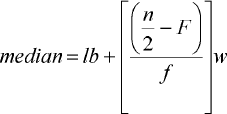RDP 1999-03: Householders' Inflation Expectations Appendix B: Data Definitions
January 1999
- Download the Paper 390KB
1. Survey Data
Inflation expectations, expectations about various other economic variables and respondent characteristics are all obtained from the Melbourne Institute of Applied Economic and Social Research Surveys of Consumers. Specific questions are listed in Appendix A.
Median inflation expectations are constructed from the frequency distribution of individual responses using the following formula.
lb = lower bound of range
n = number of observations
/ = frequency of median class
F = cumulative frequency of observations below median class
W = width of median class
Responses are weighted to reflect the gender, age and location distribution of the population and qualitative responses are distributed according to quantitative responses. These adjustments are explained in more detail in Section 2.1.1 in the text.
2. Underlying Inflation
Rate of change in the Treasury underlying CPI. Australian Bureau of Statistics, Consumer Price Index, ABS Cat. No. 6401.0.
3. Import Prices
Tariff adjusted import prices. Import Price Index, ABS Cat. No. 6414.0.
4. Unit Labour Costs
Nominal unit labour costs, Reserve Bank of Australia.
5. AWOTE
Private sector AWOTE, (sa), ABS Cat. No. 6302.0, Table 2.
6. Output Gap
Hodrick Prescott output gap estimated with real GDP(A) from 1980 to 1997, with λ = 1,600. See de Brouwer (1998).
7. Unemployment Rate
Total unemployed persons as a proportion of the labour force. ABS Cat. No. 6202.03, Table 2.
8. Cash Rate
From 1990 onwards, the target cash rate. Prior to 1990, the unofficial 11am call cash rate. Reserve Bank of Australia Bulletin, Table F.1.
9. Exchange Rates
The $US/$A and TWI exchange rate measures, May 1970 = 100. Reserve Bank of Australia Bulletin, Table F.9.
